-
A UAV that uses wind power as a bird does
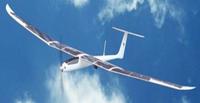
An engineering Ph.D. students wins prizes for the design of an unmanned aerial vehicle (UAV) — dubbed Green Falcon II — which would be powered by the sun and wind; “While all airplanes mimic the shape of birds, the Green Falcon II will literally use the wind to power its movement, just as a bird would,” the young inventor says
-
-
Research may yield more compact antennas for military use
Researchers say that the tall, bulky antennas the U.S. military uses could be scrapped for low-profile, broadband antennas — thanks to a different approach to antenna design that replaces large dipole antennas with a more compact and conformal multi-mode radiator
-
-
Portable wastewater system generates energy, produces drinking water
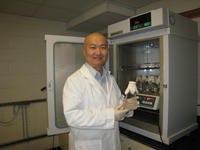
Researchers are working to develop a portable wastewater treatment system that could improve the military’s efficiency; the solar-bio-nano project also will generate energy and produce drinking water, thus providing a potential blueprint for the future of municipal/agricultural wastewater treatment systems
-
-
Large-scale power storage for the energy grid
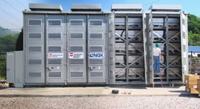
The sun does not always shine and the wind does not always blow; Stanford University researchers have used nanoparticles of a copper compound to develop a high-power battery electrode that is inexpensive to make, efficient and durable that it could be used to build batteries big enough for economical large-scale energy storage on the electrical grid
-
-
Insects to become first responders, aid in search and rescue
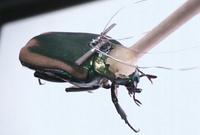
Researchers are finding ways to harvest energy from insects, holding the promise of using insects to aid in first response and search and rescue, and monitor hazardous situations before sending in humans
-
-
Harvard-designed swarm robots licensed to Swiss company
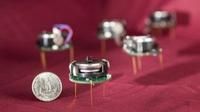
Harvard researchers developed Kilobot — a low-cost, easy-to-use robotic system for advancing development of “swarms” of robots; robot swarms might one day tunnel through rubble to find survivors, monitor the environment and remove contaminants, and self-assemble to form support structures in collapsed buildings
-
-
Jellyfish-like robot for underwater surveillance

Researchers at the Department of Mechanical Engineering at Virginia Tech built an unmanned underwater vehicle (UUV) inspired by jellyfish morphology and propulsion mechanism
-
-
Ionized plasmas as cheap sterilizer in tough places
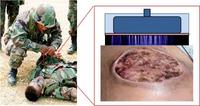
Scientists show that ionized plasmas like those in neon lights and plasma TVs not only can sterilize water, but make it antimicrobial; these plasma devices could be life-savers in developing countries, disaster areas, or on the battlefield where sterile water for medical use is in short supply and expensive to produce
-
-
Terahertz helps detection
Terahertz waves make collecting meteorological data from space, searching for flaws on an aircraft fuselage, or using certain medical diagnostics easier and more accurate
-
-
Nature inspires advances in ultrasound technology
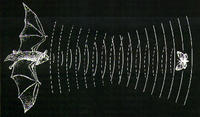
Sonar and ultrasound, which use sound as a navigational device and to paint accurate pictures of an environment, are the basis of many technologies, including medical ultrasound machines and submarine navigation systems; when it comes to more accurate sonar and ultrasound, however, animals’ “biosonar” capabilities still have the human race beat – but not for long
-
-
Brazilian fern inspires waterproof coating
A floating weed that clogs waterways around the world has at least one redeeming feature: it has inspired a high-tech waterproof coating intended for boats and submarines
-
-
Innovative ultrasonic nozzle changes the way water cleans
Scientists have developed a revolutionary ultrasonic attachment for taps, which massively enhances the ability of water to clean; currently, industry uses excessive water, power, and additives for cleaning
-
-
Hybrid power plants: cost effective way to go green
Hybrid cars, powered by a mixture of gas and electricity, have become a practical way to “go green” on the roads; now researchers at Tel Aviv University are using the hybrid approach to power plants as well
-
-
New tech could turn clothes into touch sensors
Everything from clothes and headphone wires to coffee tables could soon become interactive touch devices thanks to the development of new sensor technology; researchers at the University of Munich and the Hasso Plattner Institute are working to integrate technology originally designed to detect damaged underwater cables into touch sensors that can be installed in virtually anything
-
-
Researchers fire 1,000th shot on laboratory railgun
Scientists reached a milestone in the Electromagnetic Railgun program when they fired a laboratory-scale system for the 1,000th time on 31 October, the raygun is a long-range weapon that launches projectiles using electricity instead of chemical propellants
-
More headlines
The long view
Are We Ready for a ‘DeepSeek for Bioweapons’?
Anthropic’s Claude 4 is a warning sign: AI that can help build bioweapons is coming, and could be widely available soon. Steven Adler writes that we need to be prepared for the consequences: “like a freely downloadable ‘DeepSeek for bioweapons,’ available across the internet, loadable to the computer of any amateur scientist who wishes to cause mass harm. With Anthropic’s Claude Opus 4 having finally triggered this level of safety risk, the clock is now ticking.”
Bookshelf: Preserving the U.S. Technological Republic
By John West
The United States since its founding has always been a technological republic, one whose place in the world has been made possible and advanced by its capacity for innovation. But our present advantage cannot be taken for granted.
Autonomous Weapon Systems: No Human-in-the-Loop Required, and Other Myths Dispelled
“The United States has a strong policy on autonomy in weapon systems that simultaneously enables their development and deployment and ensures they could be used in an effective manner, meaning the systems work as intended, with the same minimal risk of accidents or errors that all weapon systems have,” Michael Horowitz writes.
Ukraine Drone Strikes on Russian Airbase Reveal Any Country Is Vulnerable to the Same Kind of Attack
By Michael A. Lewis
Air defense systems are built on the assumption that threats come from above and from beyond national borders. But Ukraine’s coordinated drone strike on 1 June on five airbases deep inside Russian territory exposed what happens when states are attacked from below and from within. In low-level airspace, visibility drops, responsibility fragments, and detection tools lose their edge. Drones arrive unannounced, response times lag, coordination breaks.
Shots to the Dome—Why We Can’t Model US Missile Defense on Israel’s “Iron Dome”
By Justin Logan
Starting an arms race where the costs are stacked against you at a time when debt-to-GDP is approaching an all-time high seems reckless. All in all, the idea behind Golden Dome is still quite undercooked.
Our Online World Relies on Encryption. What Happens If It Fails?
By Maureen Stanton
Quantum computers will make traditional data encryption techniques obsolete; BU researchers have turned to physics to come up with better defenses.
Virtual Models Paving the Way for Advanced Nuclear Reactors
By Marguerite Huber
Computer models predict how reactors will behave, helping operators make decisions in real time. The digital twin technology using graph-neural networks may boost nuclear reactor efficiency and reliability.
Critical Minerals Don’t Belong in Landfills – Microwave Tech Offers a Cleaner Way to Reclaim Them from E-waste
E-waste recycling focuses on retrieving steel, copper, aluminum, but ignores tiny specks of critical materials. Once technology becomes available to recover these tiny but valuable specks of critical materials quickly and affordably, the U.S. can transform domestic recycling and take a big step toward solving its shortage of critical materials.
Microbes That Extract Rare Earth Elements Also Can Capture Carbon
By Krisy Gashler
A small but mighty microbe can safely extract the rare earth and other critical elements for building everything from satellites to solar panels – and it has another superpower: capturing carbon dioxide.
Virtual Models Paving the Way for Advanced Nuclear Reactors
By Marguerite Huber
Computer models predict how reactors will behave, helping operators make decisions in real time. The digital twin technology using graph-neural networks may boost nuclear reactor efficiency and reliability.
Critical Minerals Don’t Belong in Landfills – Microwave Tech Offers a Cleaner Way to Reclaim Them from E-waste
E-waste recycling focuses on retrieving steel, copper, aluminum, but ignores tiny specks of critical materials. Once technology becomes available to recover these tiny but valuable specks of critical materials quickly and affordably, the U.S. can transform domestic recycling and take a big step toward solving its shortage of critical materials.
Microbes That Extract Rare Earth Elements Also Can Capture Carbon
By Krisy Gashler
A small but mighty microbe can safely extract the rare earth and other critical elements for building everything from satellites to solar panels – and it has another superpower: capturing carbon dioxide.
